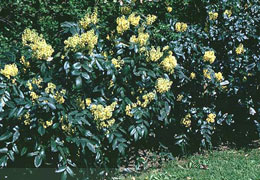


Home
Flowers &
Indoor Plants
Fruits & Nuts
Ornamentals
Vegetables
Special Topics
Resources
Glossary

Mahonia, Oregon Hollygrape |
 |
What about it? Mahonia is the state flower of Oregon, thus the name Oregon Hollygrape. It is a handsome evergreen shrub with leaves very similar to the Christmas Holly. It will grow between 4 and 5 feet in height. The young leaves have a bronze tint to them while the mature leaves have between 3-9 parts with tiny stubs at the tips. They are shiny and leathery as well. Mahonias produce dense clusters of yellow flowers at the ends of the twigs in April and May. These turn to small purple-black fruit clusters by September. What is it used for? The hollygrape is an attractive shrub that has many uses. It can be planted separately or in large groupings. It is also common to see a mahonia in a rhododendron bed. Furthermore, the handsome foliage is often cut and used in flower arrangements. Where does it grow? How do we grow it? Mahonias are quite hardy and will thrive in any soil, even a dry and sandy one. And although they are equally as tolerant about the amount of sunshine they receive, the foliage will remain a dark green if it is planted in a semi-shaded area. Sometimes direct sunlight will burn the foliage. Plant mahonias 6 feet apart for maximum growth. Pruning may be necessary in the spring to prevent the shrub from becomming too "leggy". What are its primary problems? Leaf bum from extreme heat or cold is a common problem.
© Copyright, Department of Horticulture, Cornell University. |



